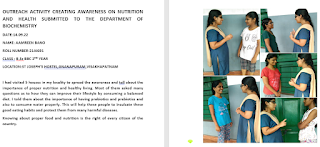September 16, 2022
World Ozone day
St. JOSEPH’S COLLEGE FOR WOMEN (A) BIOMUSKETEERS CLUB REPORT ON WORLD OZONE DAY DATE : 16th SEPTEMBER, 2022 FACULTY COORDINATORS : · Dr.P.Mary Anupama · Dr. Mousami Shankar Addala · Dr. A....
September 10, 2022
AWARENESS PROGRAM ON NUTRITION FOR BETTER LIVING
St. JOSEPH’S COLLEGE FOR WOMEN (A) DEPARTMENT OF BIOCHEMISTRY REPORT ON AWARENESS PROGRAM ON NUTRITION FOR BETTER LIVING Date- 10-09-2022 COORDINATORS- Dr. P. Mary Anupama Dr Mousami Shankar Addala Mode- Online...
September 04, 2022
Day 5- International Nutritional Webinar 2K22
Nutrition week Celebrations – day 5 Ms. Yelepu Madhuri, Senior Manager Innovations hub and operations, Nutrify today Nutrigenetics and Neutraceuticals: The next wave riding on personalized Medicine Genetic guide to good Nutrition · ...
September 04, 2022
Day 4- International Nutritional Week 2K22
NUTRITION WEEK CELEBRATIONS-DAY 4 Mrs Leela Rani, Director Lee Health Domain, Lee Pharmae Limited, Duvvada, Visakhapatnam SPEAKER: FUNCTIONAL FOODS AND NEUTRACEUTICALS. OUR PLANET, OUR HEALTH, OUR FUTURE”. Preventive health care: -Nutrition. -Movement....
September 03, 2022
Day 3- International Nutritional Webinar 2K22
NUTRITION WEEK CELEBRATIONS-DAY 3 SPEAKER: Ms DV Kavya Reddy, Food safety Officer, Vijayanagaram. TOPIC: IMPORTANCE OF SAFE FOOD AND FOOD SAFETY RULES. SOME HIGHLIGHTS OF THE LECTURE WERE: - Food Safety standards...
Powered by Blogger.



.png)

